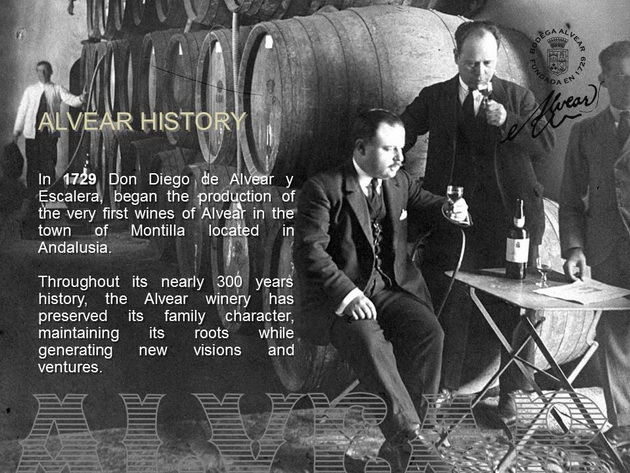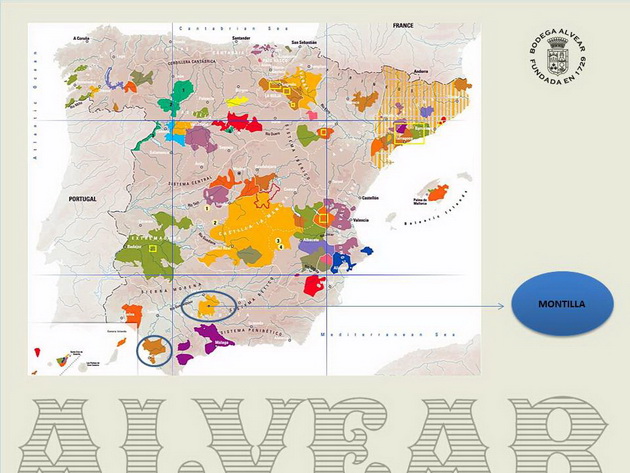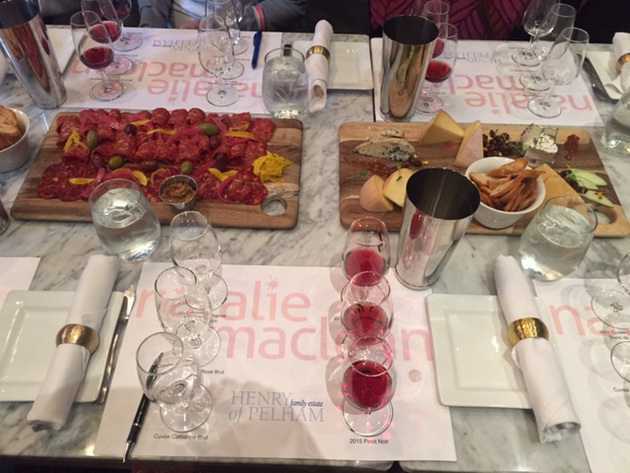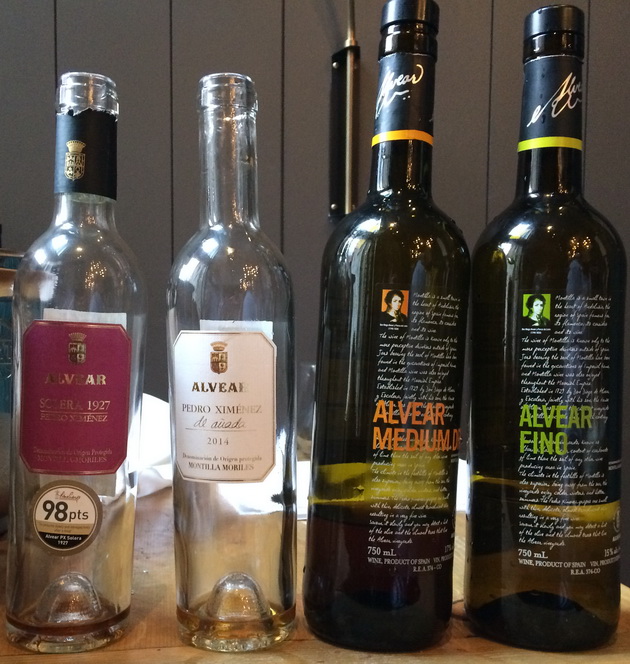Greg Hughes
Wine Writer & Sommelier
For 18 generations, (nearly 300 years) the Alvear family have been making wine. These wines use a similar production method as do the wines of Sherry, and therefore also have a similar style, yet they are unique. They are made from Pedro Ximenez grapes from Montilla Moriles instead of the traditional Palomino Fino grapes.
We had the chance to taste the wines and discuss them with Maria Auxiliadora; the winemaker responsible for their continued quality.

Pedro Ximenez (Pronounced Peh-droh ee-MAY-neth) is a small grape with a thin skin. The Pedro Ximenez grapes are nearly translucent when mature and only turn dark when they undergo the asoleado process that turns them into raisins.
It is renowned among wine enthusiasts for being super sweet and concentrated. When they’re harvested, the PX grapes are already 15% alcohol by volume. During the asoleado process sugars are concentrated.
Of the four styles available, their Fino is the lightest. It is aged as a Fino Sherry would be (under a blanket of yeast flor inside the barrel). It prevents oxidation and creates the acetaldehyde flavour that Fino is known for. It tastes soft and generous, with a saline, almond, and lemon juice/rind character.
They don’t fortify their Fino as the PX grapes naturally reach an ABV of 15%. The PX grapes come off of the vine at 15% so there is not any process keep them low in alcohol. No fortification means exactly that. No added distilled grape spirit.
The use of PX instead of Palomino absolutely impacts the mouth-feel, making it softer and more composed. It is generous and fantastic paired with olives, pickles, and other fermented food items.
The Medium Dry selection is meant to emulate a slightly sweet Amontillado, with more than five grams of sugar per litre. The term Amontillado literally means “in the style of Montilla.”

Amontillado is a protected name and Alvear is outside the Sherry area between Jerez, Sanlucar de Barrameda, and El Puerto de Santa Maria. This means they may neither call it Sherry nor Amontillado, in spite of this style arising to popularity in the mid nineteenth century in the area they currently occupy.
Amontillado is not a protected name, and it transaltes to “in the style of Montilla.” It’s a common misnomer to refer to wines from Montilla-Moriles as Sherry because of their similar production methods, and somewhat similar style.
The Consejo of Montilla-Moriles selects premium Amontiado to represent their regional bottling every two years.
These wines all compare extremely favourably to their official Sherry counterparts. However, Montilla-Moriles cannot produce Manzanilla as Manzilla can only come from Sanlucar de Barameda.
To take it a step further, Alvear are refreshingly different in their use of Pedro Ximenez. It not only showcases the grape, but how their skill can deftly transform PX into so many different styles.
Their other two offerings for the day, consisted of their extremely rich Pedro Ximenez wines. The grape is picked and desiccated on mats. It is then pressed for its extremely rarified and concentrated and dark nectar.
The straight-up PX is never fermented. It more or less is made in the same style as a vin mistelle in France. Grape spirit is added to bring the alcohol up to the level of a fortified wine. The grapes never ferment and, therefore retain their unctuous sweetness.
They provide a vintage dated PX (Añada), which provides a glimpse at young PX and how much balance and flavour it has already. The 2014 was aged for 12 months in earthenware ‘tinajas’ jars. It has a lot of fresh citrus rind, with a smoked honey spiciness. It is fantastically complex and would be able to withstand considerable aging.
However, as most PX wines are made, their PX 1927 is made using a Solera system started in the eponymous year in the name. On certain appropriate years, a selection of wine is taken from each barrel from multiple years.
The wine taken for bottling is selected only from solera casks, those casks closest to the ground. No more than a third of the wine in the solera casks is taken out at any given year. The wine is replaced with new wine from the first criadera casks located in the row above the solera casks. In turn, the wine in the first criadera is replenished with wine from the second criadera casks.
This means there will always be a portion of aged (sometimes almost ancient) wine along with young wine. It not only allows a wine producer to continue to offer a consistent ‘house style’ in spite of changing vintages, but it also gives an incredible range of brooding aged aromas and flavours as well as more youthful and vibrant notes.
David Skinner
Wine & Travel Columnist, Outdoor Magazine
Maria Alvear treated some of Ottawa’s most knowledgeable sommeliers to her family’s line of solera stylings all made from the Pedro Ximenez grape. From the Fino version to the Solera 1927 bottling, it was clear that the attention to detail that goes into the making of these sherry-style wines, pay off in layers of texture and flavors that suit a wide variety of tastes.
Maria pointed out that Jerez is the focal point for traditional sherry, but that the Alvear wines differ in two significant ways, and cannot be classified as Sherry.
First, Jerez sherry made near the ocean is primarily made from palomino grapes and consequentially, this creates a different profile that is often defined more by its salty character.
The sherry-style wines made in Montilla (well away from the influence of the sea) is made only from the Pedro Ximenez grape. This thin-skinned fruit has a high sugar content and this means that the fermentation results don’t require any fortification.
These two aspects of terroir and varietal contribute to a more rounded style of wine that is very adaptable to food or as an aperitif.
The fino version spends more than four years developing under a blanket of flor in American oak barrels. The result is a refreshing, tangy wine with some nutty accents that can stand up to dishes with vinaigrettes but is equally at home on its own (well chilled) or in a cocktail like a fino mojito or with Absinthe (for the brave).
The medium-dry version takes the fino one step further on the evolutionary scale. These wines get the oloroso treatment and spend more than 6 years in the oxidative environment of the solera system.
When they emerge from their slumber they have developed a nutty flavor with touches of fig that has a unique ability to go with both the tradition charcuterie plate but also with onion soup and spicy foods like Mexican or Thai.
For lovers of the decadent flavours offered by well-aged Oloroso sherries, there is the Pedro Ximenez Anada and the Solera 1927. Both start with fully mature grapes which are treated before vinification by drying them in the sun on mats until they become raisins.
This technique is known as “soleo” or “asoleado” with the process taking place in a pasera.
“Pasa” means raisin in Spanish, and is the same treatment that the Italians employ to make their appassimento style wines like Amarone. Given these little raisins still need to produce juice, they are subjected to two separate pressings.
The first is a screw press to get the easy part done but then these little gems are put into the same kind of press used to make olive oil, until every last bit of nectar is squeezed out. The fermentation takes place in concrete containers and then barrel aged using a three-tiered solera system.
The resultant wines are darker and more intensely perfumed with dried figs, prunes, chocolate and candied orange peel. Perfect for blue-veined cheeses and desserts.
Looking to try a range of sherry-style wines? Look no further than Alvear for its continental style and character that’s sure to please.
Doug McMillan
Accredited Sommelier & Blogger
Our tasting of Henry of Pelham wines was concluded with a fabulous tasting of Sherries from Alvear.
It seems that people either love or hate Sherry, and while I’m in the first camp, I don’t get the chance to enjoy it as much as I should, something which I plan on correcting after being reminded what I’m missing.
The four Sherries presented covered a range of tastes from Fino (dry), to sweet, and all were quite wonderful. I tend to stick to sweeter Sherry with desserts, but the dry Sherries make an excellent pairing with many different meals and are a great way of impressing guests with something different.
What still amazes me most about Sherry is the value. The work that goes into these bottles is amazing.
As an example, the “Solera” system used to make some of them still includes Sherry as far back as 1924 in one of these varieties. The Solera system takes only 1/3 of the wine from this year from the barrels, and replaces what’s been taken with 1/3 of a barrel from the previous year, which is replaced with the previous year, and so on.
It guarantees great consistency and complexity. Do yourself a favour and try something different.
Gwen Barton
Certified Sommelier
This week, I had the privilege of meeting Maria Alvear of Alvear Winery, and participating in a tasting of their wonderful sherries. Maria is the 8th generation involved in this family business which was established in 1729 – impressive!
Maria provided us with pairing suggestions, leading off with the Fino, noting how well the this young, dry wine accompanies Spanish Tapas – able to stand up to the strong flavours of some of the traditional first course offerings such as olives, smoked salmon and chorizo. The wine is fresh, zippy and yeasty with a slight salinity.
The tasting progressed through the different styles of sherry – all made using Pedro Ximenez. The medium style was smooth and sweet – and as Maria suggested, would be a great accompaniment to ‘harder to pair’ cuisines such as Thai or Indian curries.
We ended the tasting with Alvear’s deep, rich, nutty, and sweet oloroso. Generous aromas and tastes of raisin, cinnamon, cloves and cashews – Christmas in a glass!
Each sherry, though markedly unique, had a lot to offer. I learned a great deal from Maria’s explanation of sherry production and pairing suggestions – which I am anxious to try!
Jane Staples
Wine Columnist, Ottawa Wedding Magazine
I recently joined my Dream Team Wine Colleagues for a special tasting of Alvear Wines from Spain. We were privileged to have Maria Alvear with us, the Marketing Director and 8th generation direct descendent of the original founding family.
Bodegas Alvear is the oldest winery in Andalucia, started in 1729, in the hottest and driest region of southern Spain. The Alvear name symbolizes history, tradition, dedication and a deep knowledge of the wine and grape trade, specializing in wines made from the Pedro Jiménez varietal.
One of the first things I learned at the tasting was that the wines from this D.O., although like Sherry in style, are not called Sherry. They are called Montilla (as in the D.O. itself). This distinguishes them from Sherry wines made in the neighbouring coastal D.O. of Jerez.
Whew! With that matter sorted out, we continued.
The unique characteristic about Montilla is the Solera system of aging, which involves fractional blending and many rows of barrels. We tasted a beautiful Pedro Jiménez dessert wine, for example, which includes doses dating back to 1927, when that particular Solera system was started.
We tasted Spain’s favourite aperitif, Fino, with its distinctive salinity and dry, refreshing savoury aspects. Typically enjoyed before dinner, served very cold, with tapas. It apparently also works well with sushi.
Next, we tried Alvear Medium-Dry, which is slightly sweet and fuller-bodied than Fino. It goes well with strongly flavoured foods such as onion soup, tacos or spicy foods.
We finished this very informative tasting with two dessert wines, made using grapes that have been dried in the sun on grass mats. The flavour of intense Andalucian sunshine in our glasses!
These were aromatic, luxuriously rich and extremely satiny in texture. A complete delight! These are wines to be savoured, either with dessert or they could happily be dessert on their own.
This event provided an exceptional opportunity to taste some of Spain’s most coveted wine products and to learn directly from the producer.
I have to say that if you can’t visit Andalucia at the drop of a hat, this is the next best thing. Here I am stranded in Canada in windy mid-winter, dreaming of sunny Spain, so this Sherry tasting brightened my day and reviewed my wine knowledge in a very pleasantly exclusive way.
Jennifer MacDonald Havers
Wine Columnist, Ottawa Citizen
We had the pleasure of meeting Maria Alvear, an 8th generation Sherry-style winemaker from Alvear in Montilla. The history of Sherry-making is so extensive, and it was wonderful to have the opportunity to learn from someone whose family has been working in this for generations! It really gives you perspective on the tradition and uniqueness of sherry making.
What surprised me most about our tasting was the diversity of styles when you consider we tried four styles of Alvear Sherry, all made with 100% PX (Pedro Ximenez), the star grape of Montilla.
The dry or Fino style sherry was what I envision when I think of Sherry – dry, yeasty or bread-like notes from the flor which forms on the wine during the aging process. These were also a little bit briny, a little nutty, so perfect with antipasto, nuts, and olives.
Maria also recommended this style with salads and fresh tomatoes as it counters the high acidity in those foods nicely – something to try for a change, especially for those foods that are a bit more challenging to find a good wine pairing.
The sweeter styles were a lovely surprise for me, specifically the Solera 1927. The PX grapes are dried out on mats before being pressed and vinified, something akin to the Appassimento style for Amarone.
The resulting aged sherry is the most beautiful colour – a rich mahogany – and also full of flavour. There was a lot of almond, honey, and raisins on the palate and it had very full body with lots of texture. I would forego dessert for some of this anytime.
Overall, Maria provided us with a great re-introduction to Sherry-style wines, and opened our eyes to enjoying them more than just after dinner!
Kimberly Inksater
Accredited Sommelier & Blogger
I’ve always enjoyed a dry or medium (amontillado) sherry but what I didn’t know until Maria Alvear, from the 8th generation of Bodegas Alvear, explained that the term sherry or Jerez/Xérès is protected as an appellation under European law and therefore Alvear’s wines cannot be correctly referred to as sherry.
The Alvear winery is in the Montilla-Moriles appellation located in the Andulusian region of Spain, in the province of Córdoba. The “sherry-like” wines should therefore be referred to as Montilla-Moriles.
Alvear, founded in 1729, uses the Pedro Ximénez grape varietal for its Monitlla-Moriles wines. These wines use the solera system where a maximum of one third of a row of barrels is blended with the next row. This is a long and patient process but the results are spectacular and nothing like your grandmother’s sherry.
The “Fino” wine is very dry and does not need to be fortified because the veil of yeast (called “flor”) that covers the wine in the barrel fermentation process reaches a 15 % alc. and the flor eats the alcohol and glycerin. The result is so dry (with 2.5 g/l of sugar) that this Fino can be easily paired (well chilled) with pickles, olives, and sushi.
Maria shared some innovative cocktail ideas with us: try mixing Fino with absinthe or a Fino Mojito, blending Fino, mint, soda and lime (or Sprite or 7-Up) or replace vermouth with Fino in a Manhattan or martini.
For sipping I prefer the Alvear Amontialldo or Medium Dry wine. In this style, the flor of the Fino wine dies (or is purposefully halted, by adding a neutral grape-based spirit) and the wine oxidizes as it ages for more than six years in the oak barrels. While the aromas have a sweet profile of orange peel, caramel and dried fruit, there is a dry salted nut and citrus flavour in the mouth.
Maria explained that the wine is so easy to pair with charcuterie, aged cheese, tacos (Tacos al Pastor would be a perfect match) or Thai food because of the umami (savoury) characteristics.
The special treat of the Alvear tasting was Pedro Ximénez Añada 2014.
Due to the solera system the Monitall-Moriles and Jerez wines are not vintage dated. This wine is made without the solera by drying grapes in the sun for approximately seven days and then pressing them with two different presses. The wine is left to partially ferment in concrete tanks before being fortified and left for twelve months in barrels. This is an exceptional wine, perfect for blue cheese, not yet available in Ontario. Tengo que viajar a Córdoba!
Pam Chiles
Wine & Food Writer
It was a treat to meet 8th generation Maria Auxiliadora from the Alvear Family Bodegas at Social, and taste their gorgeous “sherries.” Alvear is one of the most famous producers in DO Montilla-Moriles in Spain and has a long and fascinating history (best read on their website!).
The Montilla-Moriles region almost exclusively grow Pedro Ximinez grapes. The range of wine styles that can be made from that single grape variety is astounding – from ultra-dry, refined Fino to the gooey, sweet nectars the area is famous for (it would be too much to try to decipher the varieties of sherry production here, suffice to say, it can be complicated) And they all have their individual appeal.
The two sweetest ones – Anada and Solera, in particular, got my attention, having a bit of a weakness for that classic style. The Fino was fascinating with its crisp, dry layers of flavours and textures (great with tapas of course). The Medium Dry was unique with more body and a touch of sweetness, similar to an Amontillado.
Noteworthy: Although they use the same “solera” system of rotating barrels and ageing, wines from DO Montilla-Moriles cannot be labelled as Sherry – that term is used exclusively for wines from DO Jerez, next door.
Fun Fact: The Alvear Fino does not need to be fortified (as some fino sherries do). 15% alcohol is reached through fermentation.
Hot Tip: Use the Fino in place of vermouth in cocktails – example, Fino Gin martini!
Tasting through the range and listening to Maria, one is transported to sunny, southern Spain. I believe a field trip is in order to fully appreciate these beautiful wines! However, as that is not likely to happen any time soon, after a lovely afternoon sipping and savouring, I am off to hunt the shelves of the LCBO for these Alvear gems.
Alvear’s Amontillado
Montilla Moriles, Andalusia, Spain
Alvear’s Fino Montilla
Spain
Alvear’s Pedro Ximenez De Anada
Spain








































